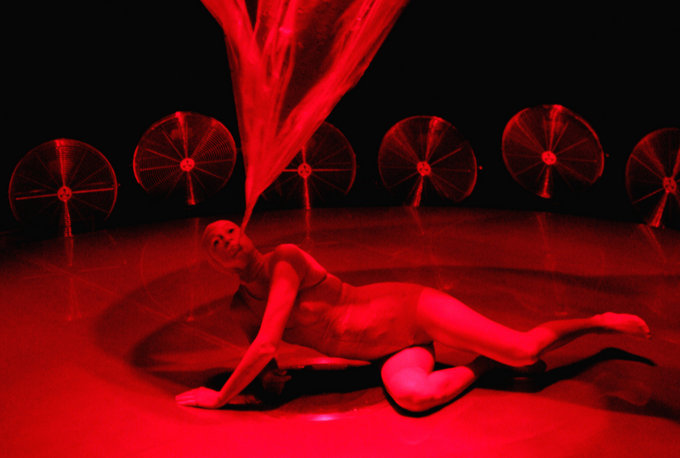‘Beneath how many layers do we hide our true selves?’ asks Phia Ménard of Company Non Nova. The question posed is explored not through words but through physical action, in one of the most intense, focused, and visceral solo performances you are likely to witness at this year’s London International Mime Festival (or indeed anywhere else).
Created and performed by Ménard, with dramaturgy by Jean-Luc Beaujault, Vortex is the dark companion piece to Compagnie Non Nova’s Total Theatre Award-winning L’Apres-midi d’un Foehn, which wowed Edinburgh Fringe audiences in August 2013. Together, these works are called The Wind Plays, although L’Apres Midi will be known forever more as ‘the plastic bag show’ as it was fondly dubbed in Edinburgh. Both shows feature the same staging: audience seated almost in the round, a dark-floored circular performance space ringed by a hefty number of heavy-duty industrial fans. In fact, both shows have a similar start: a lone performer slowly and meticulously creating a puppet character from a small pink plastic bag and a roll of Sellotape, the little person (and its companions, which are tucked away in the performer’s jacket pockets) animated in a delightful dance by the currents from the fans.
In Vortex, this start has a more ominous feel as the puppet-master is an enormous stuffed figure with every inch of flesh masked by bulky clothes, dark glasses, white gloves – Michelin Man meets Invisible Man. From there on in, the works diverge drastically. L’Apres Midi keeps the nature of animation – life, breath, movement – as its subject matter, with two possible outcomes for the little plastic bag people, depending on which version of the show you see. Vortex takes us on an ever deeper and more disturbing investigation of personal identity and the winds of change that toss us hither and thither through the world. If L’Apres Midi moves from gentle breeze to storm, Vortex takes us far further, into a world of tornados, mistrals, hurricanes and gyres – the human figure in the midst of all this wild, wild wind caught up in a tempestuous succession of metamorphoses.
Phia Ménard enacts a shamanic journey, peeling off onion layer after layer of costume/identity in the search for what is ‘real’. The metaphors jostle for attention in our mind’s eye: here, we see a snake shedding its skin, there a chrysalis with the butterfly within pushing to get out. There are very many breathtaking moments of transformation. A black plastic skin shed from one incarnation of the body on stage is animated by the wind from the fans, to rise as the now shiny white plastic body’s dark shadow. The human figure and its black bin-bag doppelgänger are pitted against each other in a terrible battle, an exploration of the archetypal terror of the evil twin that is reminiscent of the story of Gilgamesh and Enkidu. At another point, yards and yards of plastic entrails are pulled from the ever-thinning body, to be caught up by the wind into a torque of whirling and writhing high above. Later, a pregnant figure gives birth to the clearest and purest of cellophanes, animated not only by the wind, but by the intense red light beaming down from above, the transparent material shimmering with the blood-red intensity of a thousand rubies.
The piece is complete in itself, needing no further word of explanation to be a beautiful and wondrous exploration of the search for identity and the nature of change and renewal. Knowing a little about the personal history of its creator adds an additional layer of interest and understanding: Phia Ménard was formerly Philippe Ménard a transgender artist and juggler whose previous work has similarly investigated his/her life, personal identity, and the experience of living in transition – caught between states of being.
Compagnie Non Nova offers us a fantastic example of the marrying of scenography and physical performance in both works shown at LIMF 2014 – the space and everything in it manipulated skilfully by light, sound, movement and object animation. Having now seen both shows, I see L’Apres Midi and Vortex as twin works offering a different perspective on the nature of life and death, the animate and the inanimate. By repeating the beginning of L’Apres Midi in Vortex, that connection is firmly made, although this repetition is perhaps unnecessary – if you’ve seen both pieces, you make the connection anyway, and for audience members who haven’t, the beginning of Vortex is perhaps a little puzzling.
That small criticism aside, this is a tremendous piece of work – a visual theatre bursting at the seams with images that delight and haunt in equal measure. Vortex gives no answers, just more questions – the questions that we grapple with (physically, mentally, spiritually) from the moment of birth to the moment of death. Who are we? Why are we here? Where does the internal ‘me’ end and the outside world begin and end? How much power does the individual have to change, and how much is determined by external forces? A whirlwind of ideas, a wonderful show. Tout bouge, tout bouge…


